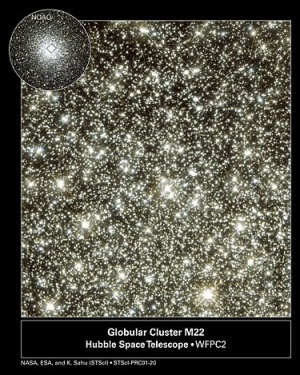Messier 22
Messier 22 is an elliptical globular cluster in the constellation Sagittarius, near the Galactic bulge region. It is one of the brightest globulars that is visible in the night sky.M22 was one of the first globulars to be discovered, on August 26, 1665 by Abraham Ihle and it was included in Charles Messier's catalog of comet-like objects on June 5, 1764.

It was one of the first globular clusters to be carefully studied first by Harlow Shapley in 1930. He discovered roughly 70,000 stars and found it had a dense core. M22 is one of the nearer globular clusters to Earth at a distance of about 10,600 light-years away. It spans 32' on the sky which translates to a spatial diameter of 99 ± 9 light-years. 32 variable stars have been recorded in M22. It is projected in front of the galactic bulge and is therefore useful for its microlensing effect on the background stars in the bulge.Two black holes of between 10 and 20 solar masses each have been discovered, initially with the Very Large Array radio telescope in New Mexico, and corroborated by the Chandra X-ray telescope, in 2012. Their detection implies that gravitational ejection of black holes from clusters is not as efficient as was previously thought, and leads to estimates of a total 5 to 100 black holes within M22.[1]
Session References
HGS Sessions - Clearing 5.5º N, 5.5º W coast of Kintyre, Scotland (peninsula) / Kilbrannan Sound -3/4/2015 HGS Sessions - Clearing El Obour City, Cairo Governorate, Egypt - 4/2/2015 [2]
References
- ↑ Messier 22
- ↑ HGS Session
Found in HGS Manual on Page 108
Found in HGS Manual on Page 115